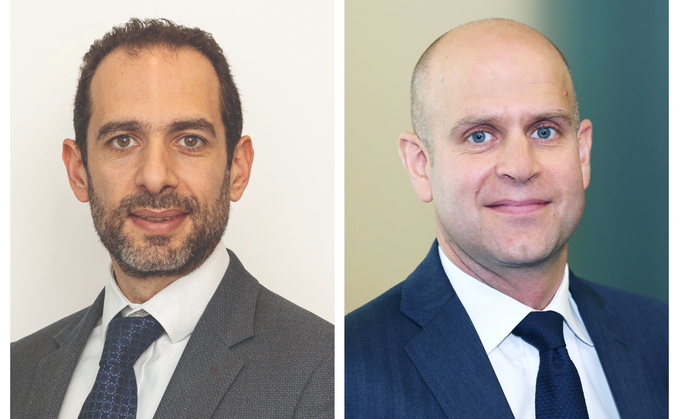
CTI's Andrew Brown and Schroders' Tim Horne
Professional Pensions held a webinar in September to discuss designing the next generation of defined contribution (DC) defaults.
The panel - chaired by PP editor Jonathan Stapleton and held in association with Columbia Threadneedle Investments (CTI) and Schroders - included CTI institutional business director Andrew Brown and Schroders head of UK institutional DC Tim Horne.
This roundtable asked whether schemes should consider a more sophisticated model for DC investment that includes a broader range of asset classes, including private market, real estate and infrastructure as well as a diversified portfolio of equity and fixed income assets.
It also assessed the barriers to some of these changes - looking at the cost implications of including these assets in a default portfolio as well as the governance and implementation challenges of such options for scheme trustees.
What are the challenges with the current approach to DC default investing, and what does the next generation DC default look like?
Andrew Brown: The potential inadequacy of pension provision is fast becoming one of the biggest socio-economic challenges facing the UK. We can't continue to rely on member contributions or push them to punitive levels to achieve good outcomes. Instead, investment and more advanced investment thinking can and should play a greater role.
DC strategies can take advantage of their positive cash flows and their long-term investment horizons to access a wider range of risk premia, embracing tangible asset classes that have additional benefits of engaging members, but this can only be achieved by advancing investment governance towards leading edge DB standards.
DC decision-makers are far less inclined to push the investment net as far and as wide as their DB counterparts, partly because, in DC, the risk is borne by the member.
A diversified and dynamically managed strategy which taps into a wider range of return drivers to diversify equity and credit risk, may be a good alternative for those expecting a relatively smooth returns journey without necessarily compromising long-run returns.
Also, a default fund needs a performance target that can be benchmarked relative to a meaningful objective, for example inflation plus 4%.
Ultimately, this is about reducing the disparity of expected returns.
Tim Horne: The structure of the market is one of the main challenges. There was a move to master trusts because of auto-enrolment which added a commercial element to the DC landscape.
Now the trustees' job is harder. They must deal with the commercial reality of working in a master trust environment where they compete with each other, particularly on price. And that involves squeezing investment budgets, which means moving away from a broad range of asset classes to a narrow range relying on equities as the mainstay of performance and returns.
In the last six months investment markets haven't been predictable, meaning we need to embrace a wide range of investment drivers for returns. We need to do that in a systematic way that allows for good governance.
In a rising rate and higher inflationary environment, how do you think we should create more resilient default funds?
Andrew Brown: It is important not to make kneejerk reactions within default fund design. That's not the job of trustees. Moreover, it's a case of providing inbuilt protection to withstand bouts of high inflation. The approach needs to factor in where members are on their journey to retirement. For example, retirees, or near retirees, are of course more inflation sensitive.
There are numerous opportunities presented by less liquid asset classes provide implicit or explicit linkage to inflation. Much of this conversation tends to lead us towards property, infrastructure, private equity and debt. But even within public markets, active managers can select stocks or sectors that perform better in high inflationary environments, providing members with more protection than a whole of market passive approach.
To what extent does the push for change and innovation in DC defaults need to come from industry versus government?
Tim Horne: Innovation should be there to aid good member outcomes but with some [initiatives] while the intention might be there, they actually put pressure on trustees to take action that is not in the best interests of their scheme members. Taking private assets as an example; if you think your scheme is going to be in a master trust, you don't necessarily want to be going in that direction.
Andrew Brown: It is both industry and government, but primarily industry.
The price of consuming pension products has become one of the predominant factors when selecting a provider and that has to some degree, stifled innovation.
The industry welcomes some of the Government's changes to the charge cap but a wider shift in mindset and approach to governance is required to progress less liquid and more innovative investments. But trustee bodies will need to ensure illiquid assets are right for their members when assessed against other investment opportunities.
The implementation challenges for innovation remain complex and greater governance resource is required if we are to enable innovative investment solutions. The industry also requires administration platforms to manage cash flows accordingly and accept greater complexity relative to public market and listed strategies.
How can smaller schemes access diversification in a cost-efficient manner?
Tim Horne: We've been investing in multi-asset - or diversified growth - funds which are a great way for any scheme to get diversification because they give access to illiquid assets.
They have a role to play, perhaps not in the first 10 to 15 years, but if you move into the middle phase, managing risk through a pooled fund is a good value-add way of doing that.
Andrew Brown: When we look at past performance, it is important to distinguish between different types of diversified growth and multi-asset funds. Governance bodies and trustees will need to look at the approach for each strategy with an understanding of how they would expect it to perform in different market environments.
Rather than simply looking at where a member is relative to their retirement date for asset allocation, multi-asset funds manage volatility, so risk control is inherent within their design. Recent events, for example, will enable multi-asset managers to protect or take advantage of opportunities - a dynamic approach.
Is there a danger we are over-reacting to what could be short-term inflation issues?
Tim Horne: We're not trying to guess every market movement, but not having any governance structure that reacts to what may be longer-term trends may miss the potential to add value.
We need to consider other return streams that give similar performance to equities, or even greater than equities, such as private assets.
The multi-asset solution is the way forward in providing a governance structure that makes investing in private markets more accessible.
To what extent do you think more money needs to be spent on DC investment to improve value for money for members?
Andrew Brown: A greater share of the member-borne fee needs to be spent on investment. Of course, investment returns are never guaranteed whereas costs are the one factor that can be controlled. But the opportunity cost of focusing on charges rather than adopting a holistic net value-added mindset could be significant.
What should the into-retirement investment journey look like? And to what extent are asset managers looking to develop capital guaranteed products for members close to retirement?
Tim Horne: We have been running funds with levels of explicit protection built in through different mechanics. Whether the funds are systematically buying protection or using other mechanisms, they typically do a good job of managing downside risk, but there is an associated cost.
As more assets come through, we will see more innovation and more protected solutions on the market.
Andrew Brown: When a member is in the pre-retirement stage, engagement is crucial, particularly given the reliance on inertia to achieve what we have with auto-enrolment. It would be catastrophic, for example, if a member were invested in long-dated gilts without the intention of buying an annuity.
Members today will see their DC pension pots in a different light to those retiring in the future, when DC savings will form the majority of worker's retirement provisions. Members may currently see their DC pension as a saving's pot which lives in a tax-privileged environment, with the ability to access 25% tax free at retirement, rather than a replacement income.
However, an element of guarantee with flexibility may be what is needed for most members in retirement. In the meantime, a more accessible advisory market would help considerably.
Are ESG or responsible investment considerations on the back foot given the current geosocial/political environment?
Tim Horne: Sustainability issues are fundamental and should be integrated across all the decision-making processes. Understanding the financial risks associated with the issues around sustainability are fundamental to long-term savings.
Andrew Brown: Sustainable investment strategies, or those with a sustainability objective, , particularly in equities, will have underperformed markedly this year. Members may be looking at that, so communication is required. But the investment belief is that investing sustainably and accounting for ESG risk factors will produce enhanced returns for members over the long term. There is no need kneejerk reactions.
How would you sum up the current DC landscape?
Andrew Brown: Defined contribution provision in the UK has moved from a period of evolution to a period of revolution in recent years. A great deal has been achieved in terms of coverage and governance but now it is time to turn our attention to the investment approach, which requires further sophistication.
Tim Horne: The market has fundamentally changed. Master trusts have done a great job of enabling auto-enrolment but also changed the landscape of the DC market.
We are working with a number of master trusts around how are they going to look to improve or move away from just having equities as the key driver of returns.
This webinar was held on 26 September in association with Columbia Threadneedle Investments and Schroders. Watch the webinar in full here.







